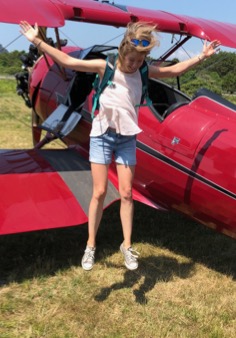I’m off to drop the bomb, so don’t wait up for me. Some of Tom Lehrer’s lyrics may have gone over my ten year old head, but that one struck home. I thought of it as I rode off from our campsite this morning, not sure when I’d be back.
There was no plan. I headed north (north ¿!?¡?!) as I left the park. I figured I’d check out the lookout tower that was under construction a year ago when I was here. After that…? I used my usual road hierarchy – town roads (named), then county roads (lettered), then state roads (numbered). Since this peninsula is not on the way to anywhere else, there are no US or Interstate highways here.
If the road had an interesting name, it would probably win – Orchard Road sounds more interesting than Townline Road. The final arbiter is that, when I get to an intersection, I look in all directions. If one catches my eye and my heart, I go that way.
I did end up on Townline Road for several miles. After aimless wandering, it was a straight shot on the border between two townships and I covered some miles without having to think about turning – and there were no cars.
One could say I was scouting the route for the century I will ride next month but one would be lying. Since I don’t know the route, I was just wandering. Not to mention that I stopped in the first half hour to hike through a Land Trust.

No map is necessary, because it is pretty hard to get lost on this narrow peninsula. Head west and you hit Green Bay. East and you find Lake Michigan. North and the end of the peninsula appears. South and you arrive in the town of Sturgeon Bay. With the sun shining, it’s pretty easy to know which way you’re going.

I found an interesting-looking coffee shop in Bailey’s Harbor. The menu looked good, there were lots of available outside tables, and the sign said “masks and social distancing required”. I put on a mask and joined the line. It’s hot breathing through a mask after a couple of hours of riding. I grew tired of waiting and got back on the road. The state highway was freshly-paved, with a beautiful paved shoulder and not much traffic (it being Wednesday morning), so I headed down the road to Jacksonport, where there is a cafe I’ve stopped at in other years up here. That cafe was closed (permanently? for the duration of the pandemic? because it’s Wednesday?), so I continued on. I thought about lunch at the brewpub in Egg Harbor (a branch of my neighborhood brewpub, owned by a guy whose dad I knew years ago), but I landed on another road with beautiful pavement and it wasn’t going that way so neither was I.
Back in the park, I climbed the steps up to the lookout tower and looked out. From there it was downhill all the way back to camp. A shower, a couple of tamales, a glass of Tuscan grape juice, and I was ready for the rest of the day.
I don’t know how far I rode, and I really don’t care. I’m on vacation. The biggest tasks for the afternoon are chasing sun for the solar charger and shade for me. Sun is harder to find and requires frequent moving of the solar panel. Work, work, work.
The park has miles of paved roads. There is a shoreline road that goes to all the places that tourists want to go, and a bunch of interior roads that “don’t go anywhere”, so no one drives on them. I spent the next day exploring those roads and think I covered every mile of the park. The first photo above is from that day.

A week without news or internet and I didn’t miss either. My cell phone had no purpose. A surprise text arrived when the wind blew the right way.







